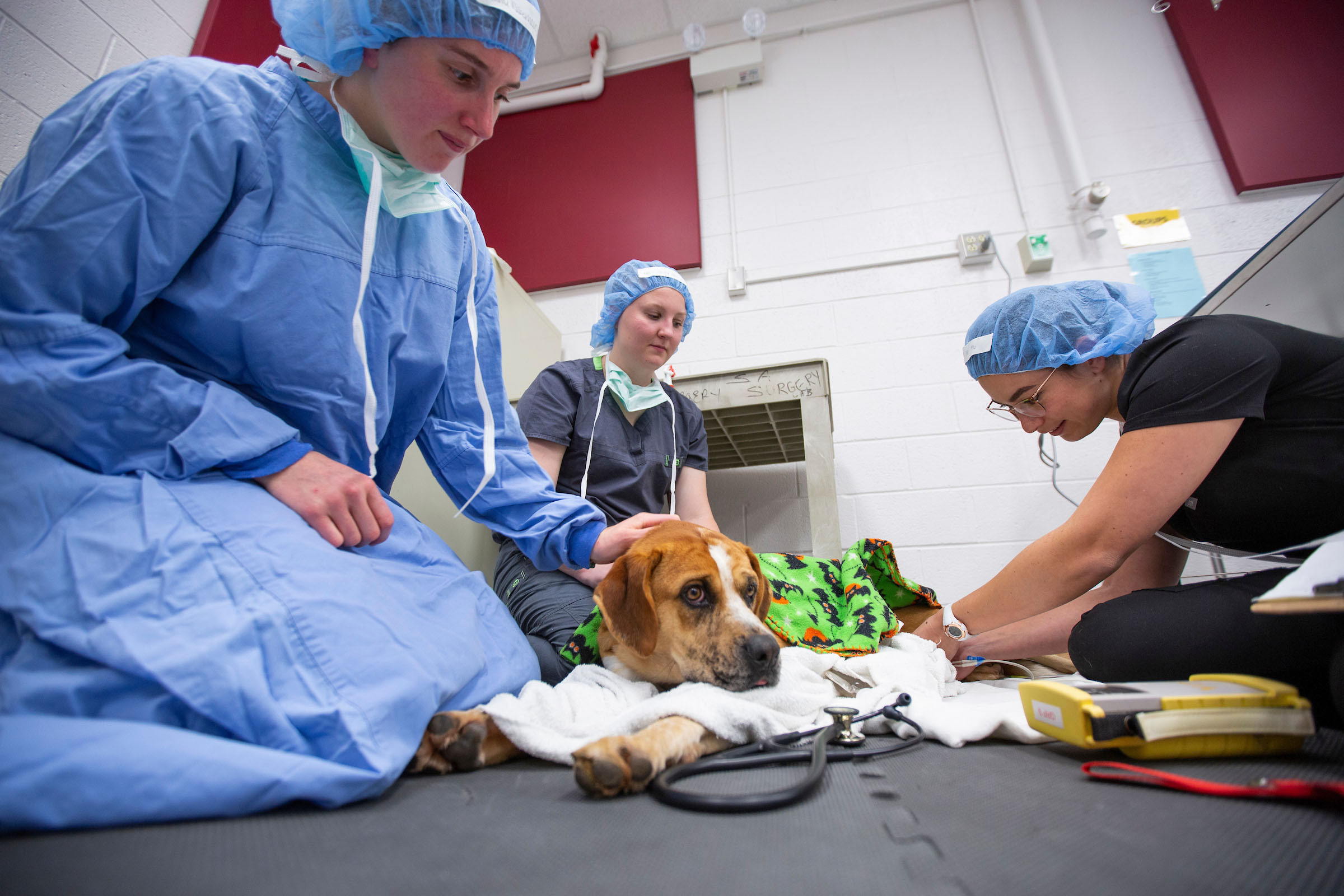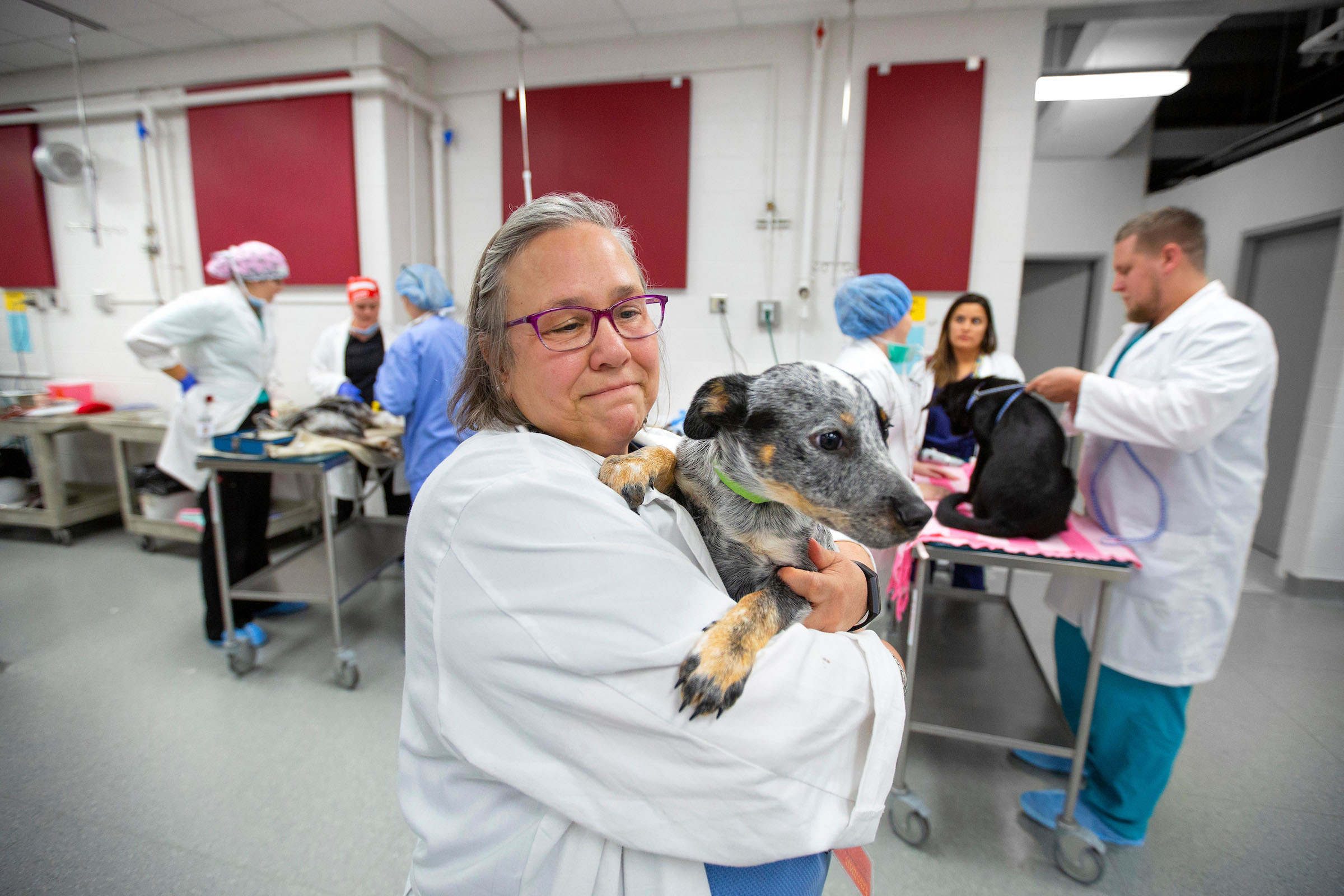AMES, Iowa – In the real world, win-win scenarios are rare and often too good to be true. But the Iowa State University College of Veterinary Medicine has pulled off an even more elusive win-win-win by providing health care to thousands of shelter animals on their way to being adopted.
ISU veterinary students win by getting experience treating live animals, and animal shelters win by saving money through the free program. The biggest winners in the equation, however, are the shelter animals, who receive a clean bill of health and usually end up being adopted into loving homes.
The ISU College of Veterinary Medicine offers a surgery, anesthesia and community outreach course as a semester-long program for third-year veterinary students, with an option for extending the course for an additional semester. Students in the course gain hands-on experience admitting patients, screening them for a wide range of health problems and performing common procedures on the animals, such as spays and neuters.
“We’re helping the shelters move animals through their program so their length of stay is decreased,” said Dr. Joyce Carnevale, a clinical assistant professor of veterinary clinical sciences who coordinates the community outreach portion of the program. “A dog or cat that receives care in our program can get adopted more readily.”
More than 300 animals, mostly cats and dogs, receive care over the course of a semester. Since the program began in 2016, more than 2,000 animals from more than 20 shelters, welfare organizations and animal rescues have gone through the program. The animals come not only from Iowa but Texas, Illinois, Missouri and beyond. And nearly all of the animals that receive care through the program wind up getting adopted, said Dr. Tamara Swor, a clinical assistant professor of veterinary clinical sciences who leads the surgery and anesthesia portions of the program.

From left, third-year veterinary medicine students Sami Naberhaus, Katie Griger and Monique Reid tend to George, a boxer-heeler mix, in the recovery room following surgery. Photo by Christopher Gannon. Larger image.
Comprehensive health assessments
On a recent afternoon in early October, a frenzy of activity unfolded in three different rooms inside the ISU College of Veterinary Medicine. In an exam room, veterinary students checked in and performed routine health screenings on several dogs. These routine procedures include blood draws and heartworm checks on dogs older than six months. It’s the first step in a process that takes five or six days during which every animal that enters the program undergoes a comprehensive health assessment, Carnevale said. The program treats all common problems presented in shelter pets, including eye, ear and skin problems and gastrointestinal parasites, she said.
A few rooms over, eight surgical teams prepared dogs to be neutered. Each team consisted of three students: a lead surgeon, an assistant surgeon and an anesthesiologist. The surgical teams rotate roles throughout the semester, ensuring each student gets a well-rounded experience. The students performed pre-operation checks on the dogs and anesthetized them, giving the animals comforting pats, rubs and ear scratches to put them at ease as much as possible.
Once a surgical team successfully anesthetized their dog, they wheeled the animal next door into an operating room with more than a dozen surgical stations. Each station comes equipped with individual monitors that offer constant updates on the patient’s vitals, as well as individual anesthesia machines. The surgeons scrubbed in to ensure everything remained sterile and then began their procedures.
Over the next hour or so, the student surgical teams completed their procedures to the steady beeps of the monitors. ISU veterinary faculty roamed the operation room, fielding occasional questions from students and monitoring the procedures.

Clinical assistant professor Joyce Carnevale holds Ernie, a shelter dog, while other dogs are prepared for surgery by third-year veterinary students at the ISU College of Veterinary Medicine. Photo by Christopher Gannon. Larger image.
A win for students and animal shelters
DaKota Tilleraas, a third-year veterinary student from Hastings, Minnesota, said the program helps students develop skills they’ll need as practicing vets. The physical exams, spays and neuters that make up a large portion of the semester’s clinical work are the “bread and butter” of practicing veterinarians, Tilleraas said, and getting experience on live animals benefits the students immensely.
Earlier this semester, as Tilleraas prepared to perform her first spay as a surgeon on a cat, she learned one of her classmates had adopted the animal. That first procedure causes many students anxiety, and Tilleraas said she felt even more tension knowing her classmate would take the cat home.
“So that was a little more pressure for me getting to do my first spay and then knowing she’s already adopted by one of my classmates,” Tilleraas said.
But the procedure went smoothly and her classmate was pleased with the results, Tilleras said.
Aislinn Ophoff, a third-year veterinary student from Terre Haute, Indiana, said her first spay on a cat went smoothly as well. So did her work as an anesthetist for a neuter, also on a cat. She said the course gives students a chance to work with cats and dogs of varying breeds, sizes and temperaments, mirroring the experiences of practicing veterinarians.
“This is really helpful in giving us just the hands-on skills, clinical experience that you don’t get when you’re sitting in a classroom from nine to five,” Ophoff said.
Ophoff also said she appreciated being able to perform the procedures under the watchful eye of faculty, who offer feedback and constructive criticism that helps the students improve.
The animal shelters benefit from the program as well, said Julie Taylor, shelter manager of the PAWS Humane Society in Charles City, which has sent animals to Iowa State for years. Taylor said the animals she’s seen go through the ISU program have all received high-quality care. And the comprehensive nature of the program, from preventive health screenings to blood tests to spays and neuters – all free of charge – saves money for shelters and gives prospective pet owners peace of mind.
“It’s great to have all those details on an animal taken care of, and then at no cost. That’s huge,” Taylor said.